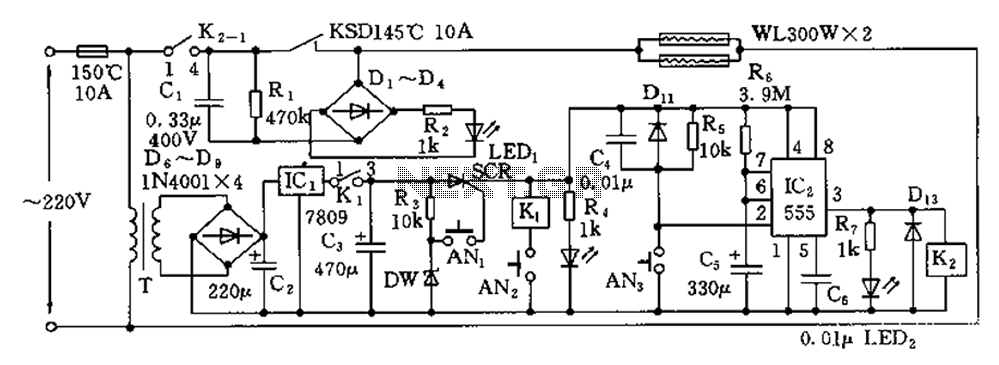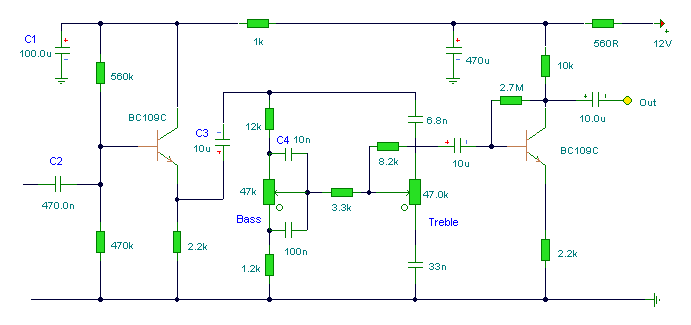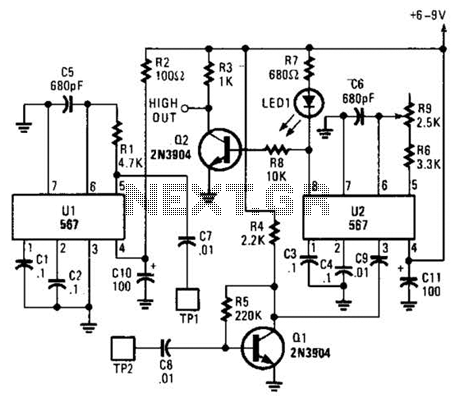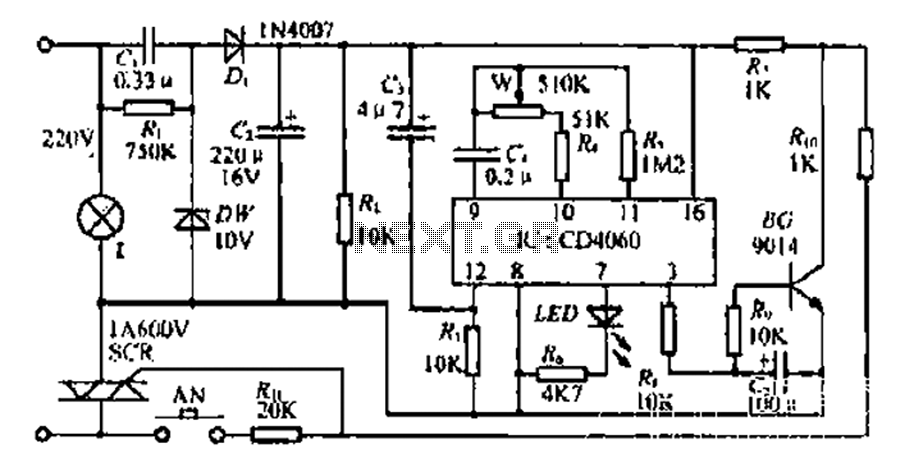
Capacitive proximity sensor detection circuit
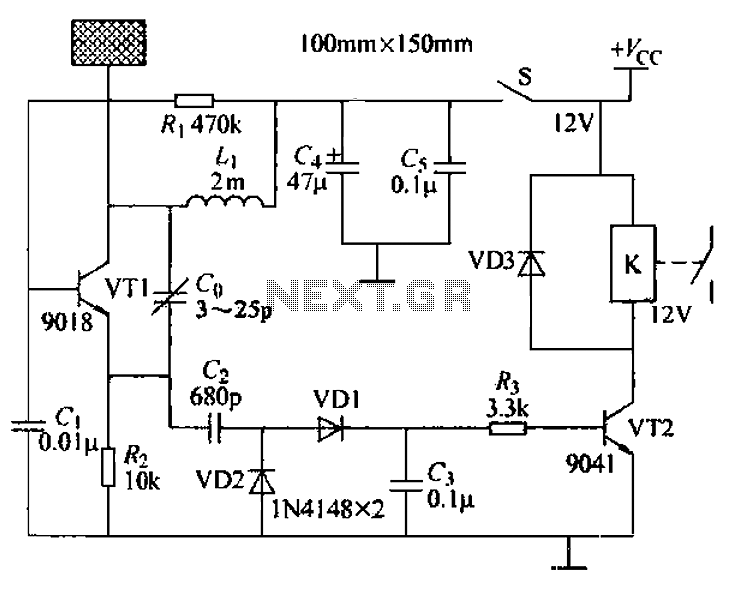
A capacitive proximity controller typically consists of a radio frequency oscillation circuit and a detection plate. The circuit is constructed using discrete components for capacitive proximity sensing detection. The transistor VT1, along with surrounding components, forms a radio frequency oscillation circuit connected to the metal sensor electrode. The collector electrode of VT1 acts as a detector. When no other conductive objects are near the sensing electrode, the oscillator circuit operates normally, with VT1 generating an RF signal through VD1 and VD2, which then detects a DC control signal. This signal activates switch VTZ, energizing a relay to power the controlled circuit. When a conductive object approaches the sensing electrode, it induces a capacitance between the electrode and the ground, reducing the positive feedback in the oscillator until it ceases oscillation. If the oscillator stops, the RF detector circuit no longer produces a linear control signal, causing VT to switch off and de-energizing the relay, which disconnects the load. The relay switch S must be reset to reconnect the circuit, allowing the oscillator to resume its operation. The sensitivity of the circuit can be adjusted using capacitor G, which influences the startup and stop thresholds of the oscillator, thereby allowing control over the distance and size of the detected object. In the circuit, the inductance of inductor L1 can range from 1 to 6 mH, and if the inductance exceeds 4 mH, it is necessary to increase the value of capacitor G to ensure smooth circuit startup.
The capacitive proximity controller operates on the principle of detecting changes in capacitance caused by nearby conductive objects. The core of the circuit is the radio frequency (RF) oscillation circuit, which utilizes the transistor VT1 as an active component. The oscillation frequency is determined by the values of the inductor L1 and the capacitor G. When the system is powered, the oscillation circuit generates an RF signal that is transmitted through the sensor electrode.
As a conductive object approaches the sensor, it alters the electric field around the sensing electrode, effectively increasing the capacitance between the electrode and the ground. This change in capacitance results in a decrease in the positive feedback necessary for the oscillator to maintain its oscillation. The decrease in feedback leads to a reduction in the amplitude of the RF signal, and eventually, the oscillator may stop oscillating altogether.
The output of the RF detector circuit is a DC control signal that is used to control the state of the relay. When the oscillator is operating normally, the control signal keeps the relay energized, allowing current to flow to the connected load. Conversely, when the oscillator stops due to the presence of a nearby conductor, the control signal drops, causing the relay to de-energize and disconnect the load.
The sensitivity of the proximity sensor can be fine-tuned by adjusting capacitor G. This adjustment allows for the calibration of the detection distance and the size of the objects that can be detected. The inductor L1's value plays a crucial role in determining the overall performance of the circuit; hence, careful selection of its inductance is necessary to ensure optimal operation. If an inductor value greater than 4 mH is used, it is essential to increase the capacitance of G to accommodate the changes in circuit dynamics and maintain stable oscillation characteristics.
In summary, the capacitive proximity controller is a versatile and effective circuit for detecting the presence of conductive objects through capacitance changes, with adjustable parameters to suit various applications. Capacitive proximity controller usually consists of a radio frequency oscillation circuit and a detection plate. Figure 6-56 is produced with discrete components capacitive pro ximity sensing detection circuit. In the figure, the transistor VT1 to surrounding parts constituting a radio frequency oscillation circuit connected to the sensor electrode metal} VT1 of the collector electrode as a detector. In the absence of other conductors near the sensing electrode, the oscillator circuit composed of a normal oscillation VT1, VT1 this time send emitter voltage RF signal by VD1, VD2 after detecting a DC control signal which enables the switch VTZ wine guide, relay energized electrical pull, turn the power of the controlled circuit; when the conductive base near the sensing electrode sheet, for any conductor near the sensing electrode are induced bun capacitor electrode sheet and the land between the capacitor the increase will reduce the amount of positive feedback oscillator until the oscillator stops vibrating swing.
If stops the oscillator, the output RF detector circuit is no longer linear flow control signal, then it will switch off VT. So that the relay is de-energized, and the relay switch S Disconnect the need to release after re-closed, the oscillation circuit in order to enter the next state, otherwise relay Electric has been disconnected.
G is the sensitivity adjusting capacitor, adjust its size can be adjusted oscillator start-up, the threshold stop vibration, thereby to adjust the controller to control the object distance and size of the project. In Figure 6-56, the inductance of the inductor L1 can be used as 1-6mH any color code inductance, if the inductance greater than 4mH, it is necessary to appropriately increase the value of G, in order to enable a smooth start-up circuit,
The capacitive proximity controller operates on the principle of detecting changes in capacitance caused by nearby conductive objects. The core of the circuit is the radio frequency (RF) oscillation circuit, which utilizes the transistor VT1 as an active component. The oscillation frequency is determined by the values of the inductor L1 and the capacitor G. When the system is powered, the oscillation circuit generates an RF signal that is transmitted through the sensor electrode.
As a conductive object approaches the sensor, it alters the electric field around the sensing electrode, effectively increasing the capacitance between the electrode and the ground. This change in capacitance results in a decrease in the positive feedback necessary for the oscillator to maintain its oscillation. The decrease in feedback leads to a reduction in the amplitude of the RF signal, and eventually, the oscillator may stop oscillating altogether.
The output of the RF detector circuit is a DC control signal that is used to control the state of the relay. When the oscillator is operating normally, the control signal keeps the relay energized, allowing current to flow to the connected load. Conversely, when the oscillator stops due to the presence of a nearby conductor, the control signal drops, causing the relay to de-energize and disconnect the load.
The sensitivity of the proximity sensor can be fine-tuned by adjusting capacitor G. This adjustment allows for the calibration of the detection distance and the size of the objects that can be detected. The inductor L1's value plays a crucial role in determining the overall performance of the circuit; hence, careful selection of its inductance is necessary to ensure optimal operation. If an inductor value greater than 4 mH is used, it is essential to increase the capacitance of G to accommodate the changes in circuit dynamics and maintain stable oscillation characteristics.
In summary, the capacitive proximity controller is a versatile and effective circuit for detecting the presence of conductive objects through capacitance changes, with adjustable parameters to suit various applications. Capacitive proximity controller usually consists of a radio frequency oscillation circuit and a detection plate. Figure 6-56 is produced with discrete components capacitive pro ximity sensing detection circuit. In the figure, the transistor VT1 to surrounding parts constituting a radio frequency oscillation circuit connected to the sensor electrode metal} VT1 of the collector electrode as a detector. In the absence of other conductors near the sensing electrode, the oscillator circuit composed of a normal oscillation VT1, VT1 this time send emitter voltage RF signal by VD1, VD2 after detecting a DC control signal which enables the switch VTZ wine guide, relay energized electrical pull, turn the power of the controlled circuit; when the conductive base near the sensing electrode sheet, for any conductor near the sensing electrode are induced bun capacitor electrode sheet and the land between the capacitor the increase will reduce the amount of positive feedback oscillator until the oscillator stops vibrating swing.
If stops the oscillator, the output RF detector circuit is no longer linear flow control signal, then it will switch off VT. So that the relay is de-energized, and the relay switch S Disconnect the need to release after re-closed, the oscillation circuit in order to enter the next state, otherwise relay Electric has been disconnected.
G is the sensitivity adjusting capacitor, adjust its size can be adjusted oscillator start-up, the threshold stop vibration, thereby to adjust the controller to control the object distance and size of the project. In Figure 6-56, the inductance of the inductor L1 can be used as 1-6mH any color code inductance, if the inductance greater than 4mH, it is necessary to appropriately increase the value of G, in order to enable a smooth start-up circuit,
Warning: include(partials/cookie-banner.php): Failed to open stream: Permission denied in /var/www/html/nextgr/view-circuit.php on line 713
Warning: include(): Failed opening 'partials/cookie-banner.php' for inclusion (include_path='.:/usr/share/php') in /var/www/html/nextgr/view-circuit.php on line 713
